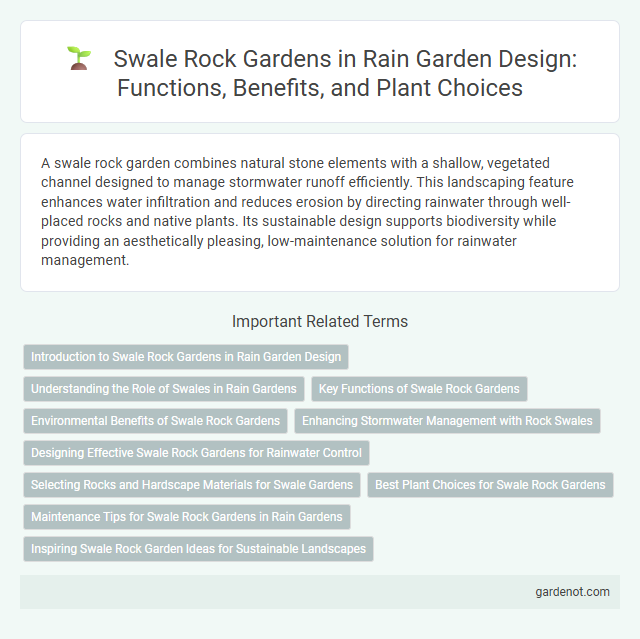A swale rock garden combines natural stone elements with a shallow, vegetated channel designed to manage stormwater runoff efficiently. This landscaping feature enhances water infiltration and reduces erosion by directing rainwater through well-placed rocks and native plants. Its sustainable design supports biodiversity while providing an aesthetically pleasing, low-maintenance solution for rainwater management.
Introduction to Swale Rock Gardens in Rain Garden Design
Swale rock gardens play a crucial role in rain garden design by effectively managing stormwater runoff through natural filtration. These gardens use strategically placed rocks and native vegetation to slow water flow, enhance infiltration, and reduce erosion in swales or shallow ditches. Incorporating swale rock gardens improves water quality, supports biodiversity, and promotes sustainable urban drainage systems.
Understanding the Role of Swales in Rain Gardens
Swales in rain gardens function as shallow, vegetated channels designed to capture and convey stormwater runoff while promoting infiltration and sediment filtration. By slowing down water flow, swales reduce erosion and help recharge groundwater, supporting native plant growth and improving water quality. Properly designed swale rock gardens enhance these benefits by incorporating permeable materials that increase water retention and provide structural stability.
Key Functions of Swale Rock Gardens
Swale rock gardens are designed to manage stormwater runoff by slowing, filtering, and directing water flow through strategically placed rocks and vegetation. They enhance infiltration, reduce erosion, and improve water quality by trapping sediments and pollutants before they enter local waterways. By mimicking natural drainage patterns, these gardens support groundwater recharge and provide habitat for beneficial insects and plants.
Environmental Benefits of Swale Rock Gardens
Swale rock gardens effectively manage stormwater by facilitating natural infiltration and reducing surface runoff, thereby minimizing soil erosion and filtering pollutants before they reach water bodies. These gardens enhance local biodiversity by creating microhabitats for native plants and beneficial insects, contributing to a balanced ecosystem. The integration of rocks and vegetation helps stabilize soil and promote groundwater recharge, supporting sustainable urban water management practices.
Enhancing Stormwater Management with Rock Swales
Swale rock gardens optimize stormwater management by directing runoff through strategically placed rocks and vegetation, promoting infiltration and reducing erosion. These rock swales slow down water flow, filter pollutants, and enhance groundwater recharge in urban landscapes. Incorporating native plants within rock swales further improves water absorption and supports local ecosystems.
Designing Effective Swale Rock Gardens for Rainwater Control
Designing effective swale rock gardens involves strategically incorporating permeable materials and native plants to enhance rainwater infiltration and reduce runoff. Proper grading ensures water slows down as it passes through the swale, maximizing sediment capture and groundwater recharge. Integrating durable rocks with appropriate vegetation creates a sustainable system for controlling erosion while supporting local biodiversity.
Selecting Rocks and Hardscape Materials for Swale Gardens
Selecting rocks and hardscape materials for swale rock gardens requires prioritizing durability, permeability, and aesthetic integration with native vegetation. Utilize porous, naturally weathered stones such as granite or limestone to enhance water infiltration and prevent erosion while complementing the swale's ecological function. Incorporate diverse rock sizes and shapes to create microhabitats and ensure structural stability, optimizing water flow and retention in the rain garden system.
Best Plant Choices for Swale Rock Gardens
Selecting native grasses like Blue Fescue, sedums such as Autumn Joy, and drought-tolerant perennials including Black-eyed Susan ensures optimal growth and water absorption in swale rock gardens. These plants offer deep root systems that enhance soil stability and promote effective stormwater management. Incorporating a mix of flowering species and evergreens supports biodiversity and maintains aesthetic appeal through seasonal changes.
Maintenance Tips for Swale Rock Gardens in Rain Gardens
Swale rock gardens in rain gardens require regular inspection to ensure proper water flow and prevent sediment buildup that can impede drainage. Remove debris and invasive weeds promptly to maintain permeability and promote healthy native plant growth. Periodic replenishment of gravel or rocks helps sustain the garden's structural integrity and enhances filtration efficiency.
Inspiring Swale Rock Garden Ideas for Sustainable Landscapes
Swale rock gardens combine natural stone elements with strategic water management to create sustainable landscapes that reduce runoff and promote groundwater recharge. Incorporating native drought-tolerant plants alongside permeable rock beds enhances soil absorption while minimizing maintenance and erosion. Creative design ideas include tiered rock formations and integrated rainwater channels that optimize drainage and support local biodiversity.
Swale rock garden Infographic

 gardenot.com
gardenot.com